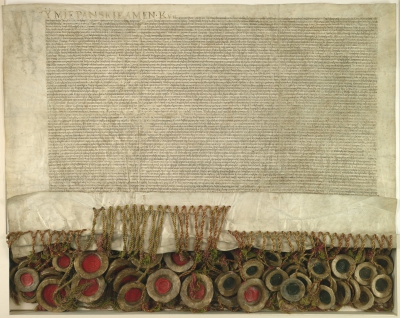The Grand Duchy of Lithuania was a European state that existed from the 13th century to 1795, when the territory was partitioned among the Russian Empire, the Kingdom of Prussia, and the Habsburg Empire of Austria. The state was founded by Lithuanians, who were at the time a polytheistic nation born from several united Baltic tribes from Auktaitija.The Grand Duchy expanded to include large portions of the former Kievan Rus' and other neighbouring states, including what is now Lithuania, Belarus and parts of Ukraine, Latvia, Poland, Russia and Moldova. At its greatest extent, in the 15th century, it was the largest state in Europe. It was a multi-ethnic and multiconfessional state, with great diversity in languages, religion, and cultural heritage.
The consolidation of the Lithuanian lands began in the late 13th century. Mindaugas, the first ruler of the Grand Duchy, was crowned as Catholic King of Lithuania in 1253. The pagan state was targeted in a religious crusade by the Teutonic Knights and the Livonian Order, but survived. Its rapid territorial expansion started late in the reign of Gediminas, and continued under the diarchy and co-leadership of his sons Algirdas and Kstutis. Algirdas's son Jogaila signed the Union of Krewo in 1386, bringing two major changes in the history of the Grand Duchy of Lithuania: conversion to Christianity and establishment of a dynastic union between the Grand Duchy of Lithuania and the Crown of the Kingdom of Poland.The reign of Vytautas the Great, son of Kstutis, marked both the greatest territorial expansion of the Grand Duchy and the defeat of the Teutonic Knights in the Battle of Grunwald in 1410. It also marked the rise of the Lithuanian nobility. After Vytautas's death, Lithuania's relationship with the Kingdom of Poland greatly deteriorated. Lithuanian noblemen, including the Radvila family, attempted to break the personal union with Poland. However, unsuccessful wars with the Grand Duchy of Moscow forced the union to remain intact.Eventually, the Union of Lublin of 1569 created a new state, the PolishLithuanian Commonwealth. In the Federation, the Grand Duchy of Lithuania maintained its political distinctiveness and had separate ministries, laws, army, and treasury. The federation was terminated by the passing of the Constitution of 3 May 1791, when it was supposed to become a single country, the Commonwealth of Poland, under one monarch, one parliament and no Lithuanian autonomy. Shortly afterward, the unitary character of the state was confirmed by adopting the Reciprocal Guarantee of Two Nations.
However, the newly reformed Commonwealth was invaded by Russia in 1792 and partitioned between neighbouring states. A truncated state (whose principal cities were Krakw, Warsaw and Vilnius) remained that was nominally independent. After the Kociuszko Uprising, the territory was completely partitioned among the Russian Empire, the Kingdom of Prussia and Austria in 1795.
The Union of Lublin (Polish: Unia lubelska; Lithuanian: Liublino unija) was signed on 1 July 1569 in Lublin, Poland, and created a single state, the Polish–Lithuanian Commonwealth, one of the largest countries in Europe at the time. It replaced the personal union of the Crown of the Kingdom of Poland and the Grand Duchy of Lithuania with a real union and an elective monarchy, since Sigismund II Augustus, the last of the Jagiellons, remained childless after three marriages. In addition, the autonomy of Royal Prussia was largely abandoned. The Duchy of Livonia, tied to Lithuania in real union since the Union of Grodno (1566), became a Polish–Lithuanian condominium.The Commonwealth was ruled by a single elected monarch who carried out the duties of King of Poland and Grand Duke of Lithuania, and governed with a common Senate and parliament (the Sejm). The Union is seen by some as an evolutionary stage in the Polish–Lithuanian alliance and personal union, necessitated also by Lithuania's dangerous position in wars with Russia.

 English
English  español
español  français
français  português
português  русский
русский  العربية
العربية  简体中文
简体中文 
